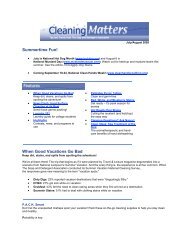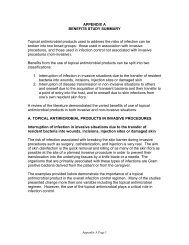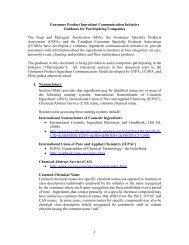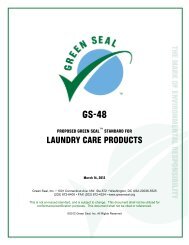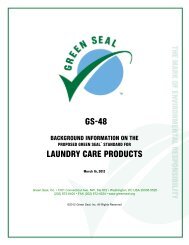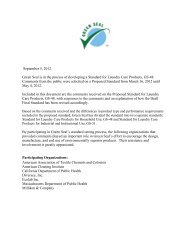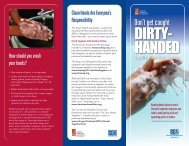subchapter c -- federal hazardous substances act regulations
subchapter c -- federal hazardous substances act regulations
subchapter c -- federal hazardous substances act regulations
You also want an ePaper? Increase the reach of your titles
YUMPU automatically turns print PDFs into web optimized ePapers that Google loves.
test for compliance with the regulation will be<br />
calibrated to insure that the force with which<br />
the mandrel is applied to a test edge does not<br />
exceed 1.35 pounds.)<br />
(e) Specifications for sharp edge test<br />
equipment. The following specifications shall<br />
apply to the equipment to be used in the sharp<br />
edge test described in paragraph (d) of this<br />
section:<br />
(1) The rotation of the mandrel shall<br />
produce a constant tangential velocity of<br />
1.00±0.08 inch per second (25.4±2.0<br />
millimeters per second) during the center 75<br />
percent of its rotation and shall have a smooth<br />
start and stop.<br />
(2) The mandrel shall be made of steel.<br />
The test surface of the mandrel shall be free of<br />
scratches, nicks, or burrs and shall have a<br />
surface roughness no greater than 16<br />
microinches (0.40 micron). The test surface<br />
shall have a hardness no less than 40 as<br />
measured on the Rockwell “C” scale, as<br />
determined pursuant to ASTM E 18–74<br />
entitled “Standard Test Methods for Rockwell<br />
Hardness and Rockwell Superficial Hardness<br />
of Metallic Materials,” published July 1974<br />
and which is incorporated by reference in this<br />
regulation. (Copies are available from<br />
American Society for Testing and Materials,<br />
1916 Race Street, Philadelphia, Pa. 19103.)<br />
The diameter of the mandrel shall be<br />
0.375±0.005 inch (9.35±0.12 millimeters).<br />
The mandrel shall be of suitable length to<br />
carry out the test.<br />
(3) The tape shall be pressure-sensitive<br />
polytetrafluoroethylene (TFE) high<br />
temperature electrical insulation tape as<br />
described in Military Specification MIL-I-<br />
23594B (1971) which is incorporated by<br />
reference in this regulation. (Copies are<br />
available from Naval Publications and Forms<br />
Center, 5801 Tabor Ave., Philadelphia, Pa.<br />
19120.) The thickness of the<br />
polytetrafluoroethylene backing shall be<br />
between 0.0026 inch (0.066 millimeter) and<br />
0.0035 inch (0.089 millimeter). 1 The adhesive<br />
shall be pressure-sensitive silicone polymer<br />
with a nominal thickness of 0.003 inch (.08<br />
16 CFR Ch. II (1–1–05 Edition)—proposed modificication – 6/25/06<br />
millimeter). The width of the tape shall not be<br />
less than<br />
1 ⁄ 4 inch (6 millimeters). While<br />
conducting sharp edge tests the temperature of<br />
the tape shall be maintained between 70 °F<br />
(21.1 °C) and 80 °F (26.6 °C).<br />
(f) For the purpose of conformance with<br />
the technical requirements prescribed by this §<br />
1500.49, the English figures shall be used. The<br />
metric approximations are provided in<br />
parentheses for convenience and information<br />
only.<br />
1 The tape that the Commission will use for the<br />
sharp edge test is CHR type ”T” manuf<strong>act</strong>ured by<br />
The Connecticut Hard Rubber Co., New and East<br />
Streets, New Haven, Conn. 06509.<br />
-- 55 --



